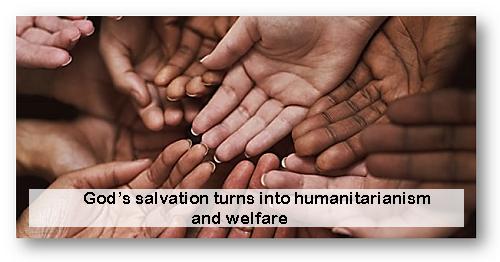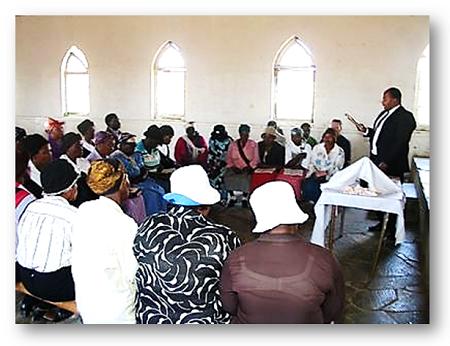Being a Missionary Church God, the Church, and the World
Being a Missionary Church God, the Church, and the World

In 2002 DTEG were given the task of serving the Reformed Churches in the Netherlands by formulating a reformed vision on what it means to be a missionary church. In their report DTEG noted two areas of tension, firstly between the starting situation and the final goal of the church and, secondly, between the biblical standard and reality. The poles of tension are often miles apart. In order to bring them together a clear vision is necessary, as well as prayer for guidance by the Holy Spirit. God wants to use churches and believers in fulfilling his plan to make the gospel known to all men.
“For God so loved the world...”⤒🔗
An Eye for the World: Biblical Foundations←↰⤒🔗
Throughout the entire history of redemption, from the beginning of the Old Testament till the New Testament period, God has approached the world with love. God’s plan of salvation is meant for all peoples and all nations. God’s covenant with Abraham and Israel is the way by which He comes to the world and seeks the nations. After Easter and Pentecost, God’s kingdom spreads into the whole world. From heaven the Lord Jesus mobilizes the believers through the outpouring of his Holy Spirit, so that they go out, speak and witness of Christ’s death and resurrection. Evangelism, therefore, belongs to the essence of the church of Christ. There is no sharing in Christ without sharing in his mission. As Risen Lord, Christ is also the centre of this mission. This focus on Christ has a number of important consequences for the missionary church, which are briefly mentioned in the report presented to Synod.
“Jesus is Lord”←⤒🔗
An Eye for the Kingdom of God←↰⤒🔗
The church of Christ plays a vital role in recognizing and establishing God’s Kingdom in the entire world.
The Old Testament declares that all nations will recognize God’s lordship one day. In the New Testament it becomes clear that the kingdom of heaven has drawn near. Through his resurrection and ascension, Jesus shows that He really is King and rules the earth.
The following can be said about this kingdom of God:
- God’s kingship is universal, in that his kingdom is there where people recognize Jesus as Lord.
- There is a difference between the reality of God’s kingdom and its realization.
- God’s kingdom in this world is dynamic in nature.
- Christians are the citizens of this kingdom and therefore live with a new perspective and display the fruits of the Spirit.
The church is not identical with the kingdom of God, but it is the place where Jesus is confessed and recognized as Lord. In this way the church is message and messenger at the same time. She bears witness to the kingdom.

“To the ends of the earth”←⤒🔗
An Eye for the History and the Form of the Church←↰⤒🔗
In the first centuries after the outpouring of the Spirit, Christianity spread across Asia, Africa and Europe. Christians were missionary in their way of thinking, speaking and behaving. When in 313 Constantine the Great was converted to Christianity, the church became a state church. Everybody became a Christian. This continued after the Reformation in the 16th century, as the government of every country decided which church was the most privileged.
The result of the Enlightenment and the French Revolution, with their rationalism and individualism, was that more and more people began to break away from the truth of the Bible. Since the Second World War, the church in Western Europe has finally disappeared from public life. Morals and culture, as well as the national laws, are no longer directly influenced by the norms and values of Christianity.
In The Netherlands churches and believers have reacted differently to the changed context in culture and society.
In the 1950’s, mainly in the Dutch Reformed Church, the model of a ‘Christ confessing people’s church’ evolved. According to this model, the church is called to speak prophetically to government and society with the aim of ‘rechristianizing’ society. Although the intention was sympathetic, this model failed because of secularization: too many people were already too long alienated from the church and the Christian faith. In the 1960’s the model of ‘the church for others’ won attention. According to this view, God is not primarily interested in the church but in the world. The church is present in society and in the wider world to fight for human rights and justice. Although the good in this has to be appreciated, actual practice shows that the proclamation of God’s salvation turns into humanitarianism and welfare. The 1970’s and 80’s saw another model of the church emerging: that of the ‘witnessing community’. From a living relationship with Jesus Christ believers are witnesses in word and deed. This more evangelical angle is to be welcomed, but it does raise the question if there is enough balance between sanctification and justification and between the realities of triumphant faith and the cross.
“In the world, but not of the world”←⤒🔗
An Eye for the Presence of the Church in Today’s World←↰⤒🔗
This chapter of the report begins with a description of trends in Dutch society. In 1999 37% of the population still consider themselves Christian, 32% have never belonged to a church and 31% characterize themselves as having left the church. The Netherlands have become a mission field, even though there are large regional differences. In addition, the influence of postmodernism on culture and society is huge.
In this changing society, the Reformed Churches (liberated) also developed. The so-called ‘ongoing reformation’ played a dominant role from the years after 1945 until the mid eighties of the last century. There was also a strong desire to equip people spiritually to become instruments through which Christ’s love could reach the world that was alienated from God. From the nineties onwards, partially because of the devastating results of secularization, the GKv gradually began to work more together with other Christians. The reformed foundations and character were maintained in this.
The increasing secularization resulted in the GKv becoming more aware of their evangelistic task. In 1975 the General Synod of Kampen pronounced: “It is inherent to the nature of the church of Christ and the gospel which has been entrusted to her, to seek those who have become strangers to God and to his service.” In 1978 this was fixed in the revised church order: “Evangelism should aim for people to join the church of Christ through profession of faith.” 1975 Synod also stated that the congregation as a whole is called to be involved in evangelism, under the supervision of the consistory.

However, thirty years after the Kampen 1975 guidelines, we have to conclude that evangelism is not one of the top priorities of the churches. Most church members are not really involved in evangelism. One of the possible reasons for this is the fact that evangelistic instruction was often directed at individual and highly motivated church members and not at the development of a congregation-wide missionary strategy. Also, until recently, there was little co-operation with other orthodox reformed churches and organizations. Finally, people were (and still are) insufficiently aware of the marginal position into which all churches have fallen after years of increasing secularization.
All this has consequences for the proclamation and the up-building of the church. In a drastically changed landscape there are chances for the Christian church if she seeks her strength in openness and new forms of community. For this reason DTEG want to work on the following goals in the coming years:
Building Stones for the Missionary Church←⤒🔗
An Eye for Practical Evangelistic Training←↰⤒🔗
The DTEG report mentions the following areas to which attention must be paid in the coming years;
- preaching and teaching;
- worship service;
- church planning;
- discipleship training;
- church planting
Evangelism and Church Planting←⤒🔗
In 2002 the General Synod decided to support the ‘Amstel Project’ generously: an initiative to set up two new churches in the Amsterdam area clearly separate from a local church. At the same time, the synod wanted a deeper study into the motives of this new way of evangelizing. For this reason, ASE was given the task “to formulate a vision on evangelism and church planting in the Netherlands.”
The ASE report is divided as follows:
1. Evangelism and Mission←↰⤒🔗
Mission and evangelism have always been two separate territories. Is it necessary to review this distinction in view of the changed circumstances?
There was a time when ‘mission’ meant that missionaries were sent out to distant countries in order to spread the gospel, to baptize those who came to faith and to set up independent churches in the mission field. Various churches worked together in supporting this missionary work. Church members were motivated to show interest and pray for the missionaries.
The word ‘evangelism’ meant evangelizing people in your own area in order to win people for God and Christ. This was primarily a task of the church members themselves. The consistory stimulated this. Each church had its own evangelistic outreach activities.
Over the last decades, the situation has changed. Many foreigners have immigrated to the Netherlands and the country has been secularized. Mission and evangelism have moved closer together. This development was noted by the Synod of Leusden in 1999. They knew that the Kampen Synod 1975 had made important statements about the character and nature of evangelism. In close conjunction with this, the Synod of 1999 stated: “It is inherent to the nature of Christ’s church to also seek those outside of her own culture and language (my emphasis, L.E.L.) who have been alienated from God and his service.” The aim of missionary work is that churches of Christ be planted so that they can have a well-ordered reformed church life of their own.

The General Synod of Leusden saw the difference between mission and evangelism mainly as a question of a difference in target group. Mission is aimed at people ‘outside our own language and culture’, whereas evangelism is directed especially at people within our own language and culture. ASE Deputies also see a difference in the ultimate organizational goal of a missionary project. In evangelism, the existing fellowship of churches is expanded, while in mission the aim is to establish such a fellowship. ASE agree to the formulation by ZH&T, but want hold on to the distinction made by Leusden 1999: “Evangelism is missionary work within the area of Dutch language and culture and is directed at the expansion of churches or church planting, always with a view to joining the existing fellowship of churches.” (my italics, LEL).
Furthermore, ASE deputies believe that the guidelines of Kampen Synod 1975 must be altered according to the current circumstances of increasing secularization, so that also evangelism with missionary characteristics fits in completely. This means concretely, that the church order should provide for evangelists and church planters who also have responsibilities as church officers.
2. Evangelism and Church Planting←↰⤒🔗
Since 2002 the Reformed Churches in the Netherlands have given national support to the so-called ‘Amstel Project’. The two ministers who have been called to this work, do not call themselves ‘evangelism ministers’ but missionary church planters. As commissioned by the previous synod, ASE deputies have studied the question of whether this development fits into the Kampen guidelines 1975.
ASE deputies have concluded that the term ‘church planting’ in current usage is unavoidably linked with the views on church planting held by Tim Keller and his fellow-workers in New York. According to Keller’s concept, it is better to plant new churches for new believers without the traditional baggage of existing churches. Newcomers will spiritually mature better in this way and old churches will ultimately be revitalized.
ASE Deputies see a number of advantages in this method:
- right from the start the church and the community are at the centre of attention
- a young, new church often bubbles over with spiritual joy and energy
- there is a desire to reach groups in society that will not easily join a traditional church.
ASE nevertheless placed a few question marks and sees two pitfalls regarding this church planting concept, which need to be taken seriously. First of all, the high and almost naive expectation that people can have of this method. Secondly, the danger of such a strong adaptation to the target group that the bond with the mother church and the fellowship of churches is weakened.
Next, the ASE report pays attention to the role of tradition, structures and culture. Certainly in the initial phase of evangelism and church formation, there must be room for the cultural identity of new churches. After a period of time the new churches and existing fellowship of churches should increasingly grow towards each other.
3, Evangelism and the Fellowship of Churches←↰⤒🔗
Within the Reformed Churches in the Netherlands, missionary projects are almost always corporately supported and financed. Since 1990 evangelistic projects have been financed jointly via a complex method of capitation if the costs are too high for a congregation. Now that there are an increasing number of national projects, the request for policy and finance is becoming more urgent. ASE Deputies chose not to centralize all evangelization projects as happened with missionary work. There should not be a general policy for evangelistic work. However, ASE does want to organize the training of evangelists, church planters and other workers centrally via the existing training institutions. Further, ASE believes it is wise to declare a new planted church as independent after a lapse of time. Supplementary financial support can then be given via art. 11 of the Church Order (‘churches in need’).

ASE also plead for setting up new projects on a small scale and urge not to fill blank spaces rashly with grand and detailed plans. Because evangelism is a task of all church members, it is good to start from the existing church. A special worker can be appointed, for example a missionary church worker.
Vision on Missionary and Church Work←⤒🔗
Finally we take a look at the report presented by the last group of missionary deputies: Deputies for Ecumenical Assistance, Missionary Work and Training (ZH&T). The missionary and church work of ZH&T abroad is divided into three parts:
- Church planting or supporting local churches in the proclamation of the gospel
- Supporting the reformed theological education and training of ministers
- Supporting the church planting work in various countries.
By the last General Synod ZH&T deputies were assigned the task of making an integral policy plan. This resulted in a document entitled “General Policy for Mission and Ecumenical Support”.
In the chapter about vision ZH&T deputies first of all refer to the starting points for mission and ecumenical help as laid down by the Synod of Leusden 1999. This Synod characterized missionary work as a calling of the local churches, which involves ‘proclamation of the Word’ as well as ‘Christian charity’.
There is a difference between church planting in areas where the gospel has not yet been heard or where there are no orthodox churches or co-operation with and support of local independent churches and denominations.
In the first instance, church planting is the aim. ZH&T defines this as follows: ‘proclamation of the gospel in word and deed to non-Christians, outside our own language and culture, with the aim of instituting a new church and establishing a fellowship of churches’.
In the second instance, missionary work can be characterized as ecumenical co-operation. The definition is then as follows: ‘activities which support an independent church or Christian institution’.
Deputies add that in this case, mission is also work ‘outside our own language and culture’ and that the co-operation falls within the ecumenical contacts of the Reformed Churches (liberated).
The overlaps with evangelism are not mentioned in the ZH&T report.
Some Main Lines Combined←⤒🔗
The General Synod of the Reformed Churches (liberated) of Amersfoort-Centrum 2005 commissioned the three groups of deputies mentioned above (and some other) to form a working group which will explore the possibility of aligning these visions and the extent to which they can be integrated. The working group will also sketch out what this means in practice: communication, co-operation or rearrangement of work. The results of these explorations will be presented to the next synod in a written report.
Having reread the three vision reports, I believe two main lines can be noted.
- The first one is that DTEG conclude that the Kampen-1975 guidelines for evangelism have had too little impact. Members of the reformed churches still show little evangelistic zeal, although according to the guidelines the responsibility for this is clearly theirs.
- ASE believes that the Kampen-1975 evangelism guidelines have to be altered in view of the continuing secularization. The Netherlands have become a mission field again. That is why evangelism and church planting should be facilitated in areas where there are hardly any churches left. This calls for evangelists and church planters with the authority of office bearers.

I think that these two main lines are not in contradiction with each other. In view of DTEG’s assignment, which is to equip evangelizing churches, it is understandable that the Kampen-1975 guidelines for evangelism should not be altered immediately. It is better for that which was so beautifully described on paper to have its impact in practice first! At the same time (in view of their assignment to formulate a reformed vision on church planting) ASE stress that the Kampen-1975 evangelism guidelines are not suitable for the new mission fields in the Netherlands, i.e. in those areas where hardly any orthodox Christians and churches are to be found. This calls for a different approach.
Perhaps the distinctions that ZH&T make as far as missionary work is concerned can also be applied to evangelism in the Dutch situation. That is: church planting in areas where the gospel is no longer found, and supporting the local church to fulfill its function of salt and light in society.

Add new comment